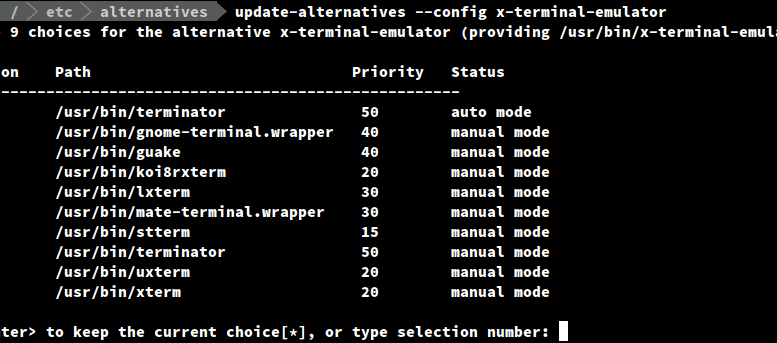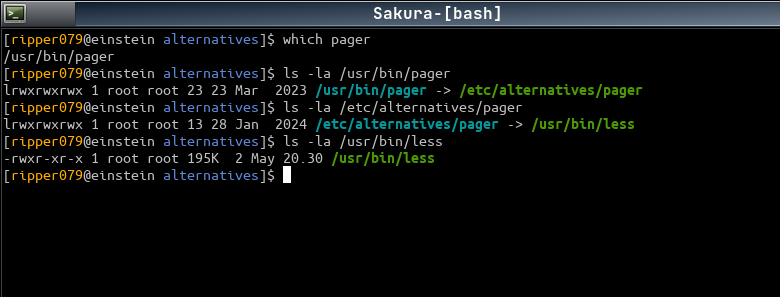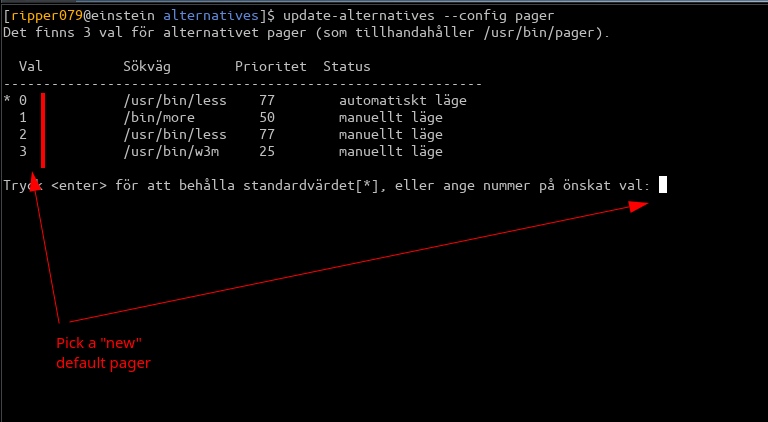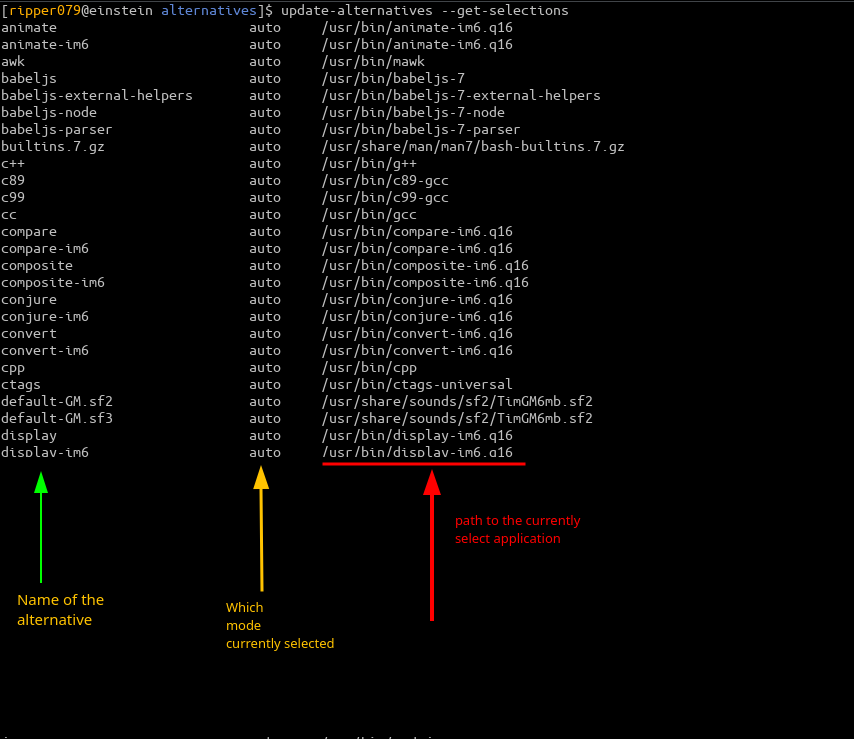/etc/alternatives
What is etc/alternatives
/etc/alternatives is a directory used in Debian-based systems to manage symbolic links for default applications or commands when multiple versions are installed. The update-alternatives command allows users to configure which version of a program should be the default by managing these symlinks, making it easy to switch between different versions of software without manual reconfiguration
Folder
/etc/alternatives
is a system for determine the default command
Application
update-alternatives
It the tool to maintain symbolic links to default command
Different påackages providing the same file need to do so cooperatively. In other words, the usage of update-alternatives is mandatory for all involved packages in such case. It is not possible to override some file in a package that does not employ the update-alternatives mechanism.
Features
- System wide
- Local override
- automagic default
- rank options (prirority -> higher wins)
- works with packages
- grouping


How to install a update-alternatives
Where is update-alternatives located
which update-alternatives
Termomonlogy and Concept
Alternatives System: A mechanism in Debian-based systems to manage multiple versions of software or commands.Symbolic Link (Symlink): A pointer or reference to another file or directory./etc/alternativesuses symlinks to point to default binaries.Master Link: The main symbolic link created byupdate-alternatives, which points to the default version of the software.Slave Links: Associated symlinks that are switched together with the master link (e.g.,javacandjava).Priority: A numerical value that defines which alternative should be used as the default if there is no manual selection.Manual Mode: A mode where a user manually selects the preferred version of a software or command.Auto Mode: The system automatically chooses the highest priority alternative if no manual selection has been made.Group: A set of related alternatives managed together (e.g.,java,javac, andjavawscould belong to the same group).Candidate: Each version or instance of software that can be selected as the default in the alternatives system.Selection: The process of choosing the default version of a command or program usingupdate-alternatives.
Examples
In order to understand links, you need to ls a lot. Lets take pager
/usr/bin/pager links to /etc/alternatives/pager
AND
/etc/alternatives/pager links to /usr/bin/less
This mean that
pager /home/joe/dummy.txt
is eqvivalent to
less /home/joe/dummy.txt

Lets pick a new alternative for pager
sudo update-alternatives --config pager

Start with a list of the name of the alternative and the path to the default version
update-alternatives --get-selections
Note:I have cropped the output in the picture

Add/Remove - Alternative Groups and alternatives
Even possible to add custom alternatives
Alternative 1
-Add
sudo update-alternatives --install /usr/bin/imagepicker imagepicker /path/to/filenametoexecutable1 10
In this case
/usr/bin/imagepicker: The symbolic link that will be created.imagepicker: The name of the alternative group./path/to/filenametoexecutable1: The actual path to the first alternative.10: The priority of this alternative (higher priority means it’s chosen by default in auto mode).
Alternative 2
sudo update-alternatives --install /usr/bin/imagepicker imagepicker /path/to/filenametoexecutable2 30
In this case
/usr/bin/imagepicker: The symbolic link that will be created.imagepicker: The name of the alternative group./path/to/filenametoexecutable2: The actual path to the seconds alternative.30: The priority of this alternative (higher priority means it’s chosen by default in auto mode).
-Remove
Remove the second option(alternative) in (group) imagepicker
sudo update-alternatives --remove imagepicker /path/to/filenametoexecutable2
Remove whe whole group (the group and ALL options) to imagepicker
sudo update-alternatives --remove-all imagepicker
This command will remove all the symbolic links and configurations associated with the imagepicker alternative group
Commands
| DESCRIPTION | COMMAND |
|---|---|
| Lists all the alternative groups and their current default selections | update-alternatives --get-selections |
|
lists all the paths associated with the "alternativegroupname" alternative group |
update-alternatives --list "alternativegroupname" |
lists all the paths associated with thepageralternative group |
update-alternatives --list pager |
|
Manually select the defualt app from from the available alternatives in the group "alternativegroup" Note: Manually mean that the ranking/priority is overridden aka local override |
sudo update-alternatives --config "alternativegroup" |
|
Manually select the default app from from the available alternatives in the group php |
sudo update-alternatives --config php
|
detailed information about thephpalternative group |
update-alternatives --display php |
Return to default (auto) mode for phpalternative group Note:Overrides the manual local mode |
sudo update-alternatives --auto php |
| To add an alternative to an existing alternative group | sudo update-alternatives --install "symlink" "name" "path-to-new-alternative" "priority" |
This command adds /usr/bin/php8.1 as an alternative for thephp groupwith a priority of 20. Note :That /usr/bin/php is the symbolic link
|
sudo update-alternatives --install /usr/bin/php php /usr/bin/php8.1 20
|
FAQ
No, /etc/alternatives and XDG values typically do not conflict because they serve different purposes within the system.
/etc/alternatives:
- Purpose: Manages symbolic links for selecting default applications or command-line tools when multiple versions or implementations are available. It’s a Debian-specific system for switching between alternatives (e.g., between different versions of Java, PHP, or text editors).
- Scope: Primarily focused on command-line tools and system-level utilities that can be accessed globally.
XDG (freedesktop.org XDG Base Directory Specification):
- Purpose: Defines user-specific directories for configuration files, data, and cache. XDG values specify where applications should store their files in a user’s home directory.
- Key Directories:
XDG_CONFIG_HOME: User-specific configuration files.XDG_DATA_HOME: User-specific data files.XDG_CACHE_HOME: User-specific cache files.
- Scope: Deals with user-specific application settings and data, mainly in graphical environments but also applicable to CLI tools.
Why They Don’t Conflict:
- System-wide vs. User-specific:
/etc/alternativesis used to manage system-wide alternatives for commands and tools, while XDG directories are user-specific and control where files and settings are stored. - Different Usage Contexts:
/etc/alternativesis mostly related to selecting between system-wide binaries and implementations, whereas XDG is about managing paths and locations for configuration, data, and caches at the user level.
Thus, they operate in parallel without colliding, as they target different aspects of system and user management.
When it comes to environment variables they can be overlap /etc/alternatives like $EDITOR, $PAGER, and others. Here’s how it works:
/etc/alternatives and Environment Variables:
- System Defaults:
/etc/alternativesprimarily sets system-wide defaults for commands likeeditor,pager, and others. When a user runs a command that calls one of these alternatives, likeeditor, the system uses the default symlink in/etc/alternatives(e.g.,/etc/alternatives/editor). - Environment Variables: Environment variables like
$EDITOR,$PAGER,$BROWSER, etc., allow individual users to override these system defaults with their own preferences. If a user sets$EDITOR=vim, it will bypass the system default set by/etc/alternativesand useviminstead.
Potential Confusion or Overlap:
- $EDITOR Example:
- The
$EDITORvariable typically points to the user’s preferred text editor (e.g.,vim,nano, etc.). - By default, if
$EDITORis not set, many programs (like Git) will fall back to using/etc/alternatives/editorto decide which editor to open. - If
$EDITORis set by the user, it will override the system-wide alternative.
- The
Resolving Any Conflict:
- User Preference Overrides: If a user defines
$EDITOR,$PAGER, or any other relevant variable in their environment (e.g., in~/.bashrcor~/.profile), that will take precedence over the/etc/alternativessystem default. - XDG and Environment Variables: XDG values are typically not involved in selecting the default system commands like
$EDITORor$PAGER. XDG is more focused on where configuration or data files are stored.
Summary:
/etc/alternativessets system-wide defaults for executables.- Environment variables (like
$EDITOR) allow users to override these defaults. - They work together without conflict because
/etc/alternativesaffects the default system-wide behavior, while environment variables give users control over their own preferences.
If no environment variable is set, the system will rely on /etc/alternatives.

